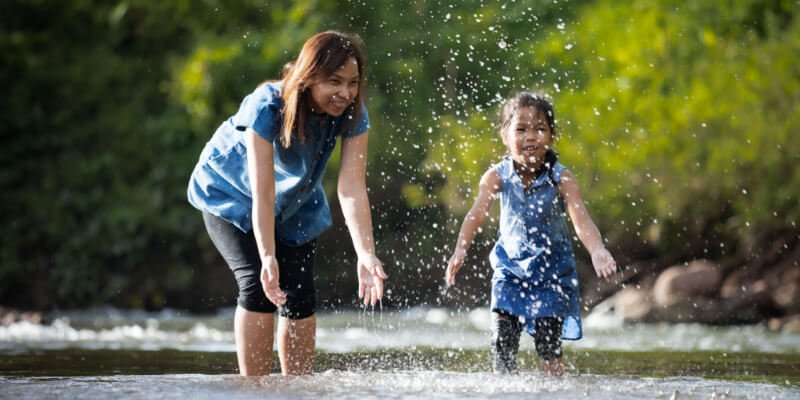
Following winter, we welcome summer. Instead of opposing cold, we now face the challenges of heat and sun. In the worst case – think of the drought in the summer of 2018 – even with a real scorching heat. That is not really nice for outdoor camping and can be just as challenging as camping in freezing cold. However, a few tips and tricks can make camping in midsummer more pleasant…
In this guide, we’ll uncover essential tips and strategies for making the most of your midsummer camping experience, ensuring you’re well-prepared to savor every moment under the sun.
Choose the Right Tent
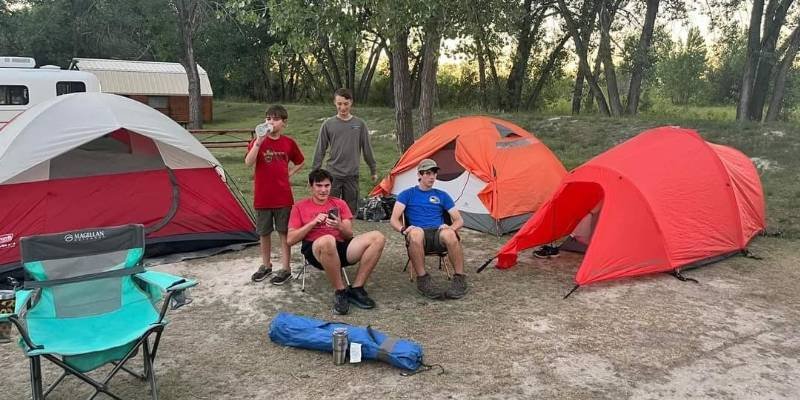
It’s crucial to choose the right tent to ensure comfort and safety during your summer camping trip. The most important thing is the type of tent. Some hiking tents have better ventilation than others. For example, a tunnel tent is not suitable for midsummer camping: This offers the best use of space, but the worst ventilation. The tunnel tent is more like a sauna than an airy tent when it is hot.
For this reason, a dome tent is suitable in this situation. Here you have less space because of the flatter walls, but top ventilation.
Now let’s see what should be followed when choosing a tent for midsummer camping…
Materials of your chosen tent
The material of the tent is an important factor for outings in midsummer. Cotton or cotton blends (technical cotton, polycotton) promise you the best room climate. Moreover, cotton provides natural insulation to keep the tent cooler during the day and warmer at night compared to synthetic materials
On the other hand, if your tent is made of plastic, especially polyester, camping in the summer heat can be a pain. Because polyester is not breathable and it keeps the heat inside the tent.
However, cotton tent is heavier and more expensive than nylon or polyester tent. Also, cotton dries more slowly than polyester. But the UV protection is better for that.
Seasonality of your tent
If you go on tour or camping, especially in summer, a summer or 2-season tent is sufficient. This is only designed for the warm months and therefore cheaper than winter-proof backpacking tents.
Choose outer tent accordingly
In summer tents, particularly those with a two-ply design, the outer tent doesn’t extend all the way down to the ground; instead, it stops short. Accordingly, backpacking tents are less weatherproof, but better ventilated because the air can circulate optimally.
- Tips: There should be as much space as possible between the inner and outer tent so that the air can actually circulate.
Number of entrances
The tent should have at least two entrances and plenty of ventilation (windows, etc.). In this way, you provide a draft if necessary, which makes camping in midsummer more pleasant. Make sure the entrances are large enough to facilitate easy entry and exit. This is essential especially in warmer weather when you might not want to linger inside the tent. It also allows for better airflow, aiding ventilation and keeping the interior cooler.
Mosquito net
A mosquito net in a tent is crucial for camping in midsummer due to the prevalence of mosquitoes and insects during this season. These tiny pests can not only be a nuisance but also pose health risks by transmitting diseases. So make sure the inner tent has large areas consisting of mosquitoes. This also air lets through much better than fabric but keeps mosquitoes outside.
- Tips: the more gauze, the better! Also good is microfiber.
Color of your tent
Pay attention to the color of your camping tent. Light is better than dark. Because light surfaces heat up less than dark ones and even partially reflect the heat. This helps to maintain a cooler interior temperature and create a more comfortable environment during hot weather.
Find the Right Place to Pitch Your Tent
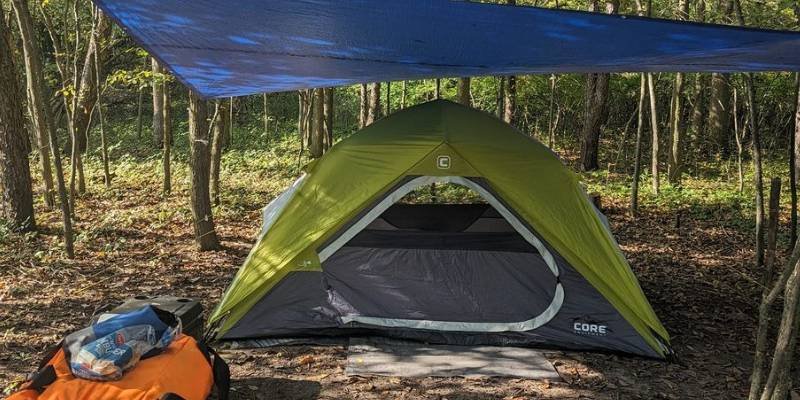
Choosing the right location to pitch your tent during a midsummer camping trip is very important for a comfortable and enjoyable experience.,.
Consider shade place
If you want to keep your tent cool, look for shade. You can find it under trees, between hills, huts, rocks or in caves.
When camping in summer, pay attention to where the sun is shining and at what time. If you want to sleep longer in the morning, put your tent west of the shade provided because the sun rises in the east. If you get up early with the birds, pitch your tent east of the shade.
- Warning: If you camp under trees, thunderstorms are dangerous. Branches can fall or even lightning can strike.
Good air circulation
Another good tip for camping in the summer heat: Find a place where the air can circulate. So where a gentle breeze blows. You can find these places, for example, on the beach, by a lake or on a hill. If you find such a place, set up your tent according to the wind. So the entrance can catch the wind.
Water availability
Speaking of breezes: you can often find one by the water. Camping in the heat therefore requires a route along the water. No matter if river, lake or sea. Why? Because the water cools the air. So camp as close to the water as possible.
In the case of a lake, pond or sea, align your tent with the water. This is how you catch the fresh breezes that come from the water. If you are camping by a river or stream, your tent entrance should point upstream. Because that’s where the cool wind usually comes from.
- Warning: water often means mosquitoes too! Less often by the sea, more often by streams and lakes.
Good for night’s sleep
When camping in midsummer, it is also important to have a place where you can sleep outside. Look for flat ground, shady areas, or trees. You can put a hammock or a tree tent between the latter. Or a tarp if you sleep under it. Avoid places with lots of insects, ticks or wild animals.
Pitch Your Tent Correctly
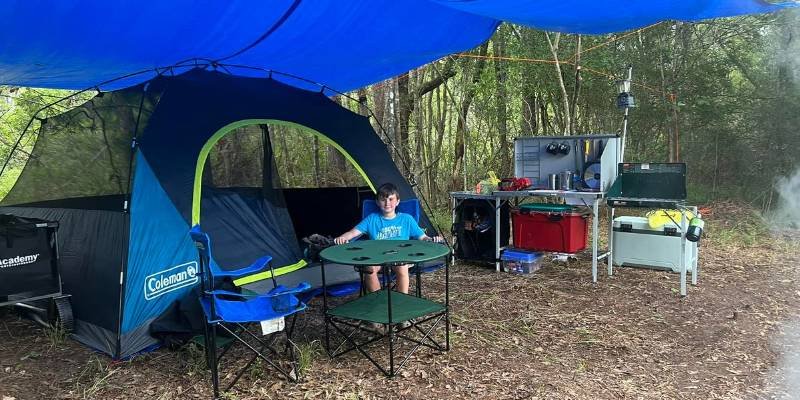
If you are not averse to some work, dig a hole or a pit. So 50, 60 cm deep. Here the earth is significantly fresher than the actual soil or the dry summer air. You can cool your tent accordingly. So try it.
- Tips: If you want to save yourself the work or you can’t dig, put a tarpaulin or foil under your tent. Although this is less effective, it can help.
Twilight
Another tip for camping in the summer heat: Only set up your tent at dusk. So you can pack your backpacking tent and store it in the shade instead of heating up in the evening sun.
Use a rain roof
Does your tent have a rain roof or is it two-ply? Then take off the flysheet if possible. This is primarily intended to keep rain and thus moisture away. However, it also keeps the heat in the tent. With the built-up inner tent alone, camping in midsummer is much more airy.
- Tips: If it rains, you can stretch the outer tent or a tarp over the inner tent so that you stay dry and can still enjoy the freshness.
Insulated blanket
Another idea: a reflective tarpaulin that you put on your tent. For example, the insulating blanket from the first aid kit is well suited. The silver side up, please.
Use an ultralight tarp
Alternatively, of course, a tarp is also possible, which then serves as a kind of awning. This also protects your tent from bird droppings and tree sap. With a tarpaulin, leave a space between the tent and the tarpaulin so the air can flow through. An insulating blanket, on the other hand, should be attached directly to the tent with duct tape. Otherwise, it will fly away quickly.
Tent dismantling
If you stay there for several days, dismantle your backpacking tent during the day. This is additional work, but this way you can pack the tent and store it in a cool place. Otherwise, this will quickly mutate into an oven when camping in the summer heat.
Keep Your Tent Cool
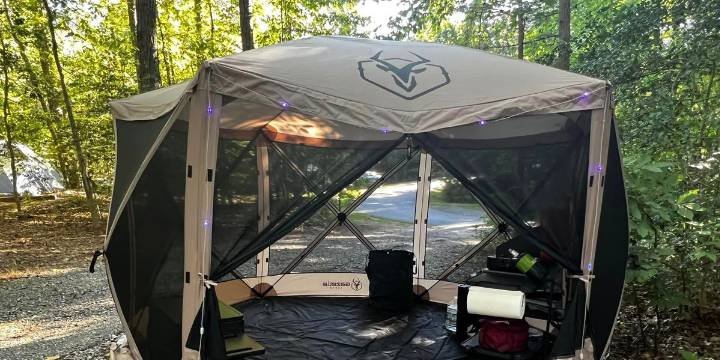
Contrary to popular belief – keep your hiking tent open as long as possible. Means: Tear open entrances and windows, provide draft (= circulation). This is how you bring cool air into the tent. Otherwise, your tent will quickly turn into a sauna.
- Tips: If there are a lot of insects in the area, pay attention to mosquito protection when buying a tent. The gauze keeps mosquitoes and the like outside, but lets in air.
Use a sleeping bag
Of course, you don’t have to sleep in your sleeping bag when camping in the summer heat. But that’s a good idea because modern sleeping bags are designed to hold warmth. On the other hand, if you are lying in a sleeping bag, the heat will not suffocate you.
- Tips: If possible, stay outside in the heat!
Use a cooler fan inside the tent
A small fan with a battery is also a good idea so that you can create a mild breeze (= circulation) when camping in midsummer.
- Place the fan in a corner of your tent. Use the oscillation mode if available. Pay attention to open windows or ventilation. Otherwise, the fan only moves the warm air in the tent.
- A little ice in front of the fan makes the air colder. Of course, ice is a deficiency on tour. The alternative is a damp towel on the fan. If you are staying at a campsite, asking about ice doesn’t hurt.
- If you don’t have a fan at hand – which wouldn’t be a surprise, especially for Ultralight backpacking – try damp towels. You put this on the outside of the tent.
Caution
Despite all these tips, camping in midsummer can have consequences. If you feel weak or confused, if you feel sick, or if you sweat extremely, leave your tent immediately. If possible, find a cool and shady spot. And drink, drink, drink! These signs are typical symptoms that you may experience a lack of water.
Extra: Practical Tips for Camping in the Heat
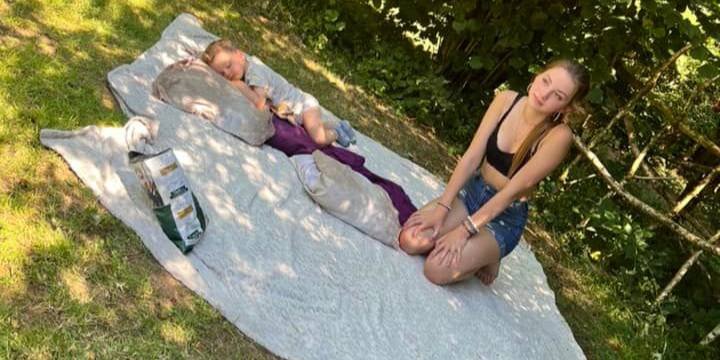
Finally, a few practical tips for camping in midsummer to make your midsummer camping more comfortable:
Number of people
No more people should sleep in your tent than the manufacturer allows. Otherwise, the motto is: the more body, the more heat. Three men in a 2-person tent not only make it tight but also warm. Maybe pleasant in winter, not in summer.
Carry thin sleeping bags
It is logical that when camping in the summer heat, you should pack a thin summer sleeping bag instead of a thick winter sleeping bag. Alternatives: a hut sleeping bag or quilt. It is usually a simple blanket that you can button or leave open. In summary, it is more airy and less cramped than a sleeping bag.
Down or synthetic fiber? In the summer, the second idea is better. First, because down is a bit too much of a good thing in summer. Second, synthetic fibers hardly absorb moisture, and camping in the summer heat means sweat. Down quickly clumps when exposed to moisture and then loses its insulating properties.
Avoid cooking inside the tent
Not a good idea when camping in summer is cooking, i.e. directly in the backpacking tent. It makes sense that you generate heat like that. Especially in the evening. From this point onwards, cooking in the tent encourages the formation of condensation water. The risk of fire is also not without. So cook outside and as far away from your tent as possible.
Breaks
Speaking of cooking: If you’re on tour in midsummer, do it like the Southerners – have a siesta over the midday heat. So from noon to 3 p.m., Sightseeing is not a good idea either except in churches or old castles, which are wonderfully fresh even in summer because of their thick walls.
No church or castle there? Then prefer a rest under a tarp as sun protection.
Camping in Extreme Heat: Personal Care
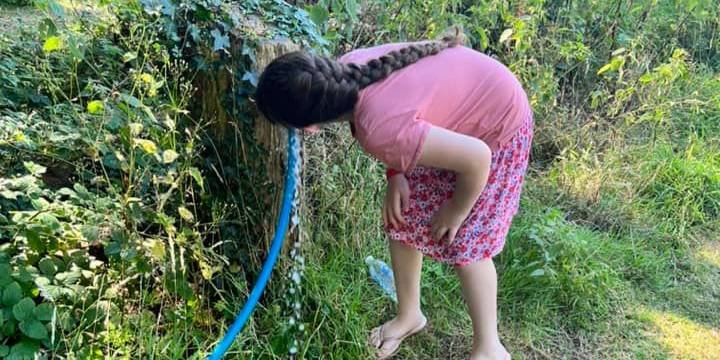
By the way, when camping in summer you should not only take care of your tent but also of yourself.
Drink well
The higher temperatures and increased physical activity associated with outdoor adventures can lead to rapid dehydration. Sweating, a natural cooling mechanism, expels vital fluids and electrolytes from the body, which necessitates regular replenishment. So drinking a good amount of water while camping in midsummer is crucial. Otherwise, your body will dry out very quickly. Consequences: headache, zero vigor, collapse.
Take care of your skin
In summer, your skin can usually prepare itself. Because of the summer sun, the skin produces melanin – and tans. However, if you drive south in winter and therefore into the sun, sunburn is no wonder. Every sunburn increases your risk of skin cancer again. It would therefore be a good idea to pre-tan in the solarium.
Make sure you have a solarium that uses UV-A as well as UV-B rays. Unfortunately, the rule is only the former. UV-A tans your skin, but only UV-B provides the necessary protection against sunburn.
- Attention: The solarium is prohibited by law for children and young people. So follow the next tips even more.
Use sunscreen for extra protection
It makes sense that sunscreen is an option to protect our skin. Get advice on this from a pharmacy or drugstore, because depending on the main type, more or less sun protection is necessary. Nevertheless, do not stay in the sun longer than necessary, even with sunscreen. Shade is the best protection from the sun.
- Tips: Don’t skimp on sunscreen. Apply the stuff generously and renew the protection from time to time, especially on the water because it reflects the UV rays.
Clothes and Hats Mean Sun Protection…
Sun protection is crucial, especially during midsummer camping when the sun can be intense. Here are some tips for choosing the right clothes and hats for sun protection:
Clothing
As well as proper clothing of course important for comfortable camping in midsummer. The rule here is: Long is better than short. Instead of white cotton – which lets a lot of UV rays through – they opted for polyester or special sun protection clothing.
- Tips: do it like the Bedouins. Airy-thin, cut wide, but completely covered.
Head
Incidentally, this includes your head, especially if you have cropped hair or a bald head. Hats with a brim or angler’s hats (Boonie hats) are very good; they also protect the ears and neck. Remember, caps with a net-like top or visor caps (headband plus peak). With these, sun protection is practically zero.
Sunglasses
Sunglasses are also a good idea when hiking and camping in midsummer. Pay attention to a large frame with wide temples so that you banish the dangerous side light.
Again, the frame should be as wide as your eye sockets. The upper edge extends to the eye sockets and the lower edge to the zygomatic bone. Also, look out for the UV-400 certificate. Then the sunglasses protect against UV-A and UV-B rays.
- Tips: wear your glasses all the time, especially when you are in the water. This reflects and amplifies UV rays. By the way, it doesn’t matter how dark the glasses are, even light glasses can correspond to UV-400. If you generally wear glasses, ask your optician for prescription sunglasses.
That’s it!
Do you have other tips for camping in midsummer or have any questions or confusion? Then post a comment!
Do you like this article? Then share it on the social web.
Thank you so much!